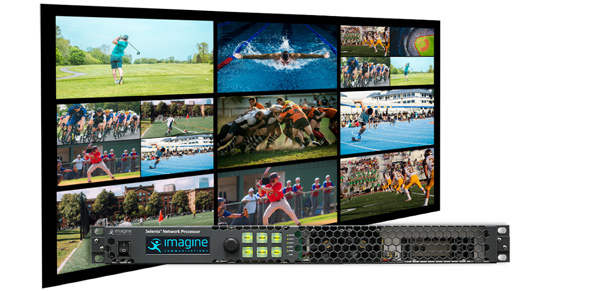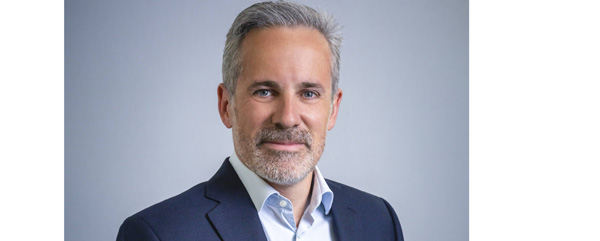CTO Bevan Gibson at EMG, talks about using IP to centralise control and increase remote access to sports events, with Imagine’s SNP making hardware deployments far more efficient.

Euro Media Group (EMG), a global broadcast services and media systems supplier for live sports, entertainment and events, combines expertise and experience to control the production value chain, from image creation to distribution. A significant part of the group’s business lies in covering major sporting events.
Bevan Gibson, CTO at EMG, notes that sports broadcasting has always driven technological development. “If viewers demand more angles and more replays, broadcasters respond with more cameras, more resolution like 4K and HDR UHD, and more graphics,” he said. “To stay ahead of the curve, our developments aim to add value to the production, while delivering savings in costs and people. One way in which we do this is through the use of IP connectivity to centralise control and increase remote access.”
Achieving this goal led to developing EMG’s IP fly-pack system, a completely modular production system called diPloy, built into modular racks of varying sizes in dedicated 40-foot containers. They can then plug together the functionality needed for each particular job. By creating modules at the flight case level, they can physically place modules where they are required – some close to the action, some at variable distances away.
Centralising Production
One of the first major uses of diPloy was at the major multi-sports event held in Japan in the summer of 2021 where they were responsible to the host broadcaster to deliver much of the technical architecture.
The centre of the event was the athletics stadium. This venue hosted the opening and closing ceremonies, as well as the programme of track and field events. “To cover the requirements for all events held at all venues, and to set up full redundancy for the opening ceremony, we built a total of eight similar control galleries situated inside the stadium’s broadcast compound, in a building about 500m away,” said Bevan.
“The first step was to bring the outputs of cameras and microphones from within the stadium to the control rooms, and to connect the feeds to a diPloy rack, also within the stadium. Dark fibres then carried the uncompressed IP signals over to the broadcast compound, where they were made available for production, via IP.”

Imagine Communications SNP in Multi-viewer personality.
The cameras were mainly 4K/UHD HDR units, although some POV cameras worked at different resolutions. Connectivity was mainly IP, but the diPloy racks could also accept SDI inputs. At the control room end, while much of the switching was in the IP domain, they were using existing replay servers, again with SDI outputs that needed to be converted to SMPTE ST 2110 IP.
Software Personalities
A critical component of diPloy is the Selenio Network Processor (SNP) developed by Imagine Communications. The SNP is a compact appliance that uses software to make a whole range of functionality available. Each 1RU SNP has four independent processors, each with eight 3G processing paths with software ‘personalities’ that can be readily changed to do what you need at any moment.
That functionality includes SDI to IP conversion, up-, down- and cross-conversion and colour space transforms, video processing and audio shuffling, point multiviewers and many other tasks. The SNP also works as the interface to high-speed IP connectivity between units – up to 400 gigabit ethernet over fibre in the current version.
Bevan said, “As the industry continues moving towards higher resolutions, European broadcasters are currently looking towards both 4K and high dynamic range colour, while American channels want 1080p HD with HDR. SNP incorporates these different conversions so we can deliver different outputs to different feeds, simply and transparently – that is, without the user being aware of the re-configuration.
“We can change what each processor path in each SNP can do with the click of a mouse. It is an excellent combination of power and flexibility, and we regard it as the great workhorse of diPloy.”
Events at other Venues
This past summer in Tokyo, the SNPs’ essential job was to convert incoming signals and multiplex them onto fibre for delivery to multiple control galleries, where more SNPs split the feeds out for production. This happens completely transparently and with virtually no latency. “As far as the crew is concerned, the performance is just the same as having SDI cameras plugged into the tailboard of a truck,” said Bevan.
“To have built eight galleries in the athletics stadium, which was only going to be used for a small proportion of the entire multi-sport event, would of course have been highly inefficient. Instead, we took further diPloy racks, again equipped with SNPs, out to cover events held at other venues, while producing them from the stadium galleries.

Bevan Gibson, CTO at EMG
“The road cycling, for example, was based at a venue more than 100km away, but was successfully cut and mixed in one of the stadium galleries. SNPs in the diPloy racks at the venue multiplexed all the signals onto a high-bandwidth IP link.”
The coverage of the cycling also involved cameras on motorbikes, helicopters and fixed wing aircraft. The receivers for these were positioned to get the best live reception, and where necessary, further SNPs were used to connect the downlinks to the control room. Regardless, the latency as the signals were converted, multiplexed and presented to the production switcher was so low that the director did not notice.
The Future for diPloy
Bevan said, “What this event gave us was a very demanding, very public proof of the diPloy concept, which successfully separates the source of signals from the production capabilities. Away from the four-yearly cycle of major events, this has a great potential for routine sports coverage.
“We have already built a diPloy-equipped control suite in our Dutch facility, and we are working on similar galleries in other major European cities. The object is to provide centralised production, which will deliver savings in budget and environmental impact as well.”
A conventional truck might cover three football matches in a week, within a relatively limited geography. But a diPloy control room could cover three football matches a day by simply routing the appropriate devices. Furthermore, the games could be anywhere. Bevan described a situation in which the same director and production team could cover two Tier 1 football matches in a single shift – the afternoon game in Manchester, and the evening game in Prague. Or a local director could be sitting in front of a production switcher panel in a Czech facility, with the replay server team in Amsterdam and the audio supervisor in London.
“This separation allows us to address the pain points of remote sports production,” he said. “For example, multiple football and rugby matches may all occur at 3pm on a winter Saturday, putting a great strain on the limited number of outside broadcast trucks. Being able to spread the load over multiple centralised production facilities means that not only are the football and rugby covered, but resources are still available for hockey and handball.”

Selenio Network Processor, rear view
More Utilisation, Less Travel
diPloy gives EMG a much higher utilisation of the equipment than if it spent more than 50% of its life powered down while a truck drives up and down the autobahns of Europe. That utilisation makes sophisticated production facilities available at a lower cost, allowing broadcasters to produce high-quality coverage for second tier sports and niche events.
“We can build more comfortable production areas than can be fitted into a truck, with space for the team to relax between games,” said Bevan. “Spending more time doing the creative job and less time travelling contributes to staff satisfaction. A reduction in the number of people, and especially in the amount of kit travelling to remote locations, also makes a demonstrable reduction in the carbon footprint.
“Working with Imagine Communications on the SNP has been very productive and we are looking forward to the implementation of JPEG XS in SNP, which will allow us to get even more signals down a fibre connection with minimal latency. With its different, interchangeable personalities in a compact 1RU chassis, SNP has become a central part of our diPloy architecture. diPloy, we believe, is the future of live sports broadcasting.” imaginecommunications.com




